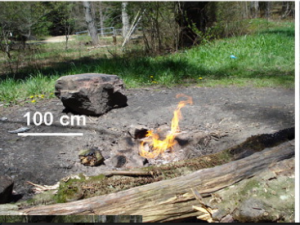"Natural Fracking" Fuels Eternal Flames

Courtesy of Indiana University
An eternal flame shines through a waterfall in Erie County, NY. The methane fueling the flame is from a natural seep originating in the Rhinestreet Shale.
As researchers debate the overall greenhouse gas impact of shale gas extraction, it turns out that nature has its own way of fracking and releasing methane into the atmosphere. Scientists refer to this as natural seepage that occurs through seismic activity, or earthquakes, which release the pressurized gas and send it up through cracks in the Earth then out into the atmosphere. Sometimes, the seepage is large enough that it ignites, creating an eternal flame.
“It could be caused by a lightning strike or a forest fire,” says Arndt Schimmelman, a geologist at Indiana University in Bloomington, Ind. “They were probably lit by people, the seepage could be millions of years old.”
Schimmelman has a grant from the Department of Energy to trace how much methane is escaping through natural fissures into the atmosphere and contributing to climate change. He says naturally occurring methane seeps could account for up to one-third of the Earth’s total methane emissions.
“People don’t know how much methane from shale gas naturally escapes from outcrops. So we said, let’s go for the obvious flames.”
Schimmelman and his research partner, Maria Mastalerz, contacted one of the world’s experts on eternal flames, the Italian researcher Giuseppe Etiope from the National Institute of Geophysics and Volcanology in Rome. Etiope travels across the world on the hunt for eternal flames, which can originate in a variety of formations. Etiope was excited, he told Schimmelman and Mastalerz that obscure eternal flames existed in Pennsylvania and New York and he was willing to fly to the U.S. and help them with the search.
The natural torches weren’t easy to find, but the researchers did locate a flame behind a waterfall in Erie County, NY. For Etiope, it was the most beautiful eternal flame he had ever seen. But Schimmelman and Mastalerz say its significance extends beyond its beauty.
A continuous source of thermogenic gas is thought to originate deep enough in the earth where high temperatures would essentially cook the organic matter and turn it into methane. But Schimmelman and Mastalerz say that’s not the case with the Erie County, NY flame, where they’ve traced the source to 400 meters below the surface in a formation known as the Rhinestreet Shale.
“The traditional hypothesis of how natural gas forms is you have to heat to more than boiling water,” says Schimmelman. “But our rock here is not that hot and has never been that hot. So the theory has a flaw, this source of gas is active without high heat.”
Schimmelman says they’re very confident about the source of the gas that’s creating the waterfall’s eternal flame.
“It suggests some other mechanism is going on,” he said.
So if it’s not heat, what could it be?

Courtesy of Indiana University
An eternal flame the size of a campfire burns in Forest County, Pennsylvania. Researchers say the source is an old abandoned gas well.
“It could be some minerals present that help do this,” says Maria Mastalerz. “It could be iron, it could be nickel, which act as a catalyst. Otherwise, you can’t explain how a flame can burn for millions of years without exhausting the source of gas.”
Mastalerz says scientists have floated this idea before, but have been ridiculed for it. So she and Schimmelman plan to be back in Pennsylvania on the hunt for these flames.
“We want to quantify how natural seeps contribute to greenhouse gas,” says Masterlerz.
One “eternal flame” found by the researchers turned out not to be from natural tectonic activity, but human activity. An eternal bonfire burns in Forest County, which the researchers determined came from an old abandoned oil or gas well, which is not properly plugged.
“The gas from that fire pit contains hydrogen gas,” says Schimmelman. “And that is typically a sign for buried metal.”
















